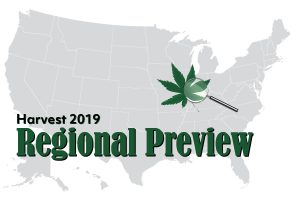Midwest region harvest preview: Indiana hemp farmers put focus on fiber
FeaturedIndianaIndustrial Hemp NewsMarijuana Laws, Regulations, & Politics September 20, 2019 MJ Shareholders 0



(Editor’s Note: This is the first of an occasional series of regional reports looking at the 2019 hemp production season leading up to harvest.)
The 2019 hemp production season has been much like what many describe the hemp and CBD industry: The Wild West.
In the absence of federal hemp production guidelines, hemp farmers were directed to grow the crop under the varying state rules under the 2014 Farm Bill hemp pilot research program.
With limited data and guidance available about modern hemp production from seed to sale, producers have been largely left to their own instincts. But some hemp farmers found help from more experienced fellow farmers, consultants and some university extension specialists with hemp backgrounds.
Indiana represents the Midwest
Hemp Industry Daily caught up with Marguerite Bolt, hemp specialist with Purdue (University) Extension in its Department of Agronomy, to find out how Midwestern farmers in her state fared with the 2019 production season.
According to the Office of Indiana State Chemist, Indiana licensed 130 farmers this year, with roughly 5,300 acres for outdoor production and approximately 400,000 square feet of indoor production.
Indiana made national news this week when a federal judge threw out the state’s ban on smokable hemp, saying it was unconstitutional.
Bolt said more than half of Indiana farmers planted fiber varieties in 2019, with 35% focused on growing hemp flower for CBD production and 15% planting hemp for grain.
Here is the rest of Bolt’s season summary:
Weather conditions
May and June were very wet months. Rainfall was well above normal in the northern part of the state in May, and near normal in some areas of the southern part of the state.
June also brought below-normal temperatures; across the state they were 1°F-3°F below normal.
In July, areas of central and northern Indiana had drought conditions. There was increased rainfall and humidity in some areas of the state during August.
In September, above normal precipitation is predicted.
Planting challenges
Wet weather in May and June delayed planting of hemp in most regions of Indiana.
Specifically, some fields intended for CBD hemp did not get planted until the middle or end of July.
Delayed planting was common for grain and fiber growers, too.
Disease and insect pressure
Leaf spots, southern blight, white mold and gray mold (were) mostly observed with the increased humidity and rainfall in mid-August.
Flea beetles from May to July were a big complaint, with some corn earworm mid-July into August.
Eurasian hemp borer was found in a northern county of Indiana, but there is not any apparent yield loss at this time; borers were found at the end of August.
Cannabis aphid populations increased in mid-August and populations continue to increase at some grows.
Farmers are also observing some fall webworm damage in the hemp.
Pesticides and biocontrols
Indiana does not have a list of allowable pesticides, so growers should not have applied anything.
Some indoor growers have released parasitic wasps for control of cannabis aphid; some have also used predatory mites for the control of spider mites.
Fertilizers
Some growers used fish emulsion, kelp, chicken manure, urea, potash and diammonium phosphate.
Some growers applied fertilizer and incorporated it in the soil preplant, while others did sidedress applications and used fertigation.
More data will come from the mandatory field summary reports at the end of the year.
Varieties
Most CBD growers used photoperiod-dependent varieties; however, there were several growers that also planted autoflower hemp varieties.
CBD growers received seed and clones from outside the state and common varieties are the cherries (Cherry Uno, Cherry Cinco, Cherry Wine, Cherry Blossom and more), Merlot, Suver Haze, Hawaiian Haze, T1 and T2.
Grain growers planted X-59, a Canadian variety distributed by Legacy Hemp.
Fiber growers planted seed distributed by Sunstrand.
Live inputs
The reports growers submit at the end of the year should give a better estimate (on percentage used of seeds versus clones).
This is the first-year growers are doing CBD production, so they do not know which varieties will work best for their farms.
Grain and fiber producers did not have much of a choice. They also likely would not have a preference because it is the first year of larger scale production in Indiana.
Indiana growers produced 60% fiber, 35% CBD (and) 5% grain.
Seed germination rate
Germination rate was 50%-90%; this was extremely variable.
Expected harvest date
Fiber plants should have been harvested in August, and most have been.
Grain harvest is expected by the end of September, possibly into October.
CBD harvest of autoflowers is underway or complete. CBD harvest for photoperiod-dependent (varieties) is underway for some; others expect to harvest all the way into mid-October or until a hard freeze.
Harvest plans
All the fiber and grain growers are using equipment.
CBD growers are mostly using labor with pruners or Weed Eaters to harvest the plants. A few growers will use machinery, but I have not seen this yet.
Crops sold
All growers were supposed to have a buy-back agreement or contract.
(This interview was edited for clarity and length.)
Laura Drotleff can be reached at [email protected]
Subscribe to our Newsletter
MJ Shareholders
MJShareholders.com is the largest dedicated financial network and leading corporate communications firm serving the legal cannabis industry. Our network aims to connect public marijuana companies with these focused cannabis audiences across the US and Canada that are critical for growth: Short and long term cannabis investors Active funding sources Mainstream media Business leaders Cannabis consumers











No comments so far.
Be first to leave comment below.